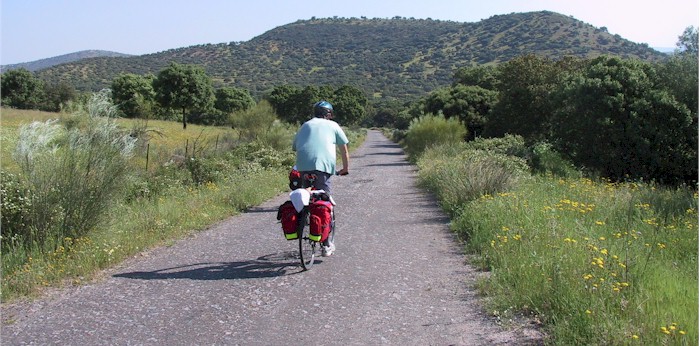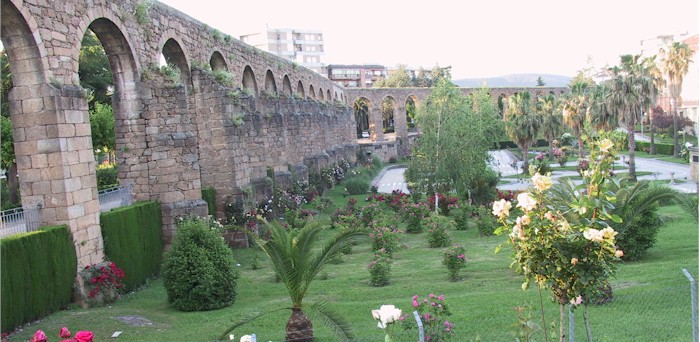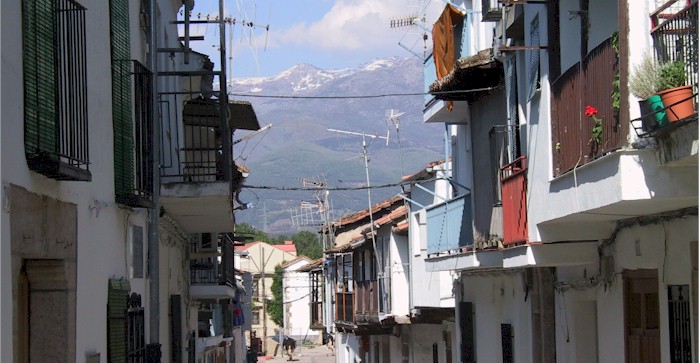Spain, Via de la Plata (Camino de Santiago)
The Via de la Plata, one of the Camino de Santiago routes, is the longest of the pilgrim routes in Spain. Starting from Seville in Andalucia, and running northwards through the provinces of Extremadura and Castilla y Leon to Salamanca and Zamora.
There is a great amount of information about the Camino de Santiago on the Internet and in guide books. Most of the information is for people walking the various routes and not much information is available for persons cycling the routes. On the Via de la Plata, its not necessary to stay completely on the hiking route to find your way to Santiago de Compostela. Riding the small agricultural roads is straight forward and there is little traffic. Small cities and villages with places to stay and food are available near the hiking route.
You can make up your own route as you travel north from Seville, just use the small roads. The map and KML file available here are for reference, it is not necessary to exactly follow the route. The train system can be used to skip over areas you don't want to ride. Excellent place to visit along the way are: Salamanca, Zamora, the coast of Galicia, A Coruña and Fisterra.

Leaving Seville.
Guides, Maps and Other Information
There is a great deal of information about the Camino de Santiago and Via de la Plata on the Internet. This is just a sample of the information available and probably some of the more useful.

Via de la Plata Tourist site promoting the route.
 Bicigrino site. Has lots of information on the various routes including the Via de la Plata.
Bicigrino site. Has lots of information on the various routes including the Via de la Plata.
 Description of Via de la Plata section by section detail.
Description of Via de la Plata section by section detail.
 Active forum for the Camino with lots of information.
Active forum for the Camino with lots of information.
 John Hayes on the Via de la Plata. Also lots of information on other routes.
John Hayes on the Via de la Plata. Also lots of information on other routes.
 Spanish Cycling Federation. Nothing specifically on Via de la Plata but the site has loads of information on biking in Spain. Use the map to find routes.
Spanish Cycling Federation. Nothing specifically on Via de la Plata but the site has loads of information on biking in Spain. Use the map to find routes.
Try searching "Via de la Plata" on Amazon. There are a large number of guides on Amazon.
See the Maps and Guides page for more mapping information.
Map information
There are many cycling apps with maps available for iphone and android. A couple of the better offline apps are listed here.
 Can be used to follow this route (and other routes) Click here for a KML file that can be loaded into the app. Via de la Plata Cycleway. Place the file in the maps.me bookmarks folder (MapsWithMe/bookmarks on your phone or tablet) or alternately, email/text it to your device and open the file with maps.me. Total Commander works great for managing and opening files.
Can be used to follow this route (and other routes) Click here for a KML file that can be loaded into the app. Via de la Plata Cycleway. Place the file in the maps.me bookmarks folder (MapsWithMe/bookmarks on your phone or tablet) or alternately, email/text it to your device and open the file with maps.me. Total Commander works great for managing and opening files.
 Guru Maps has the ability to show map types other than OpenStreetMap, in particular it will display OpenCycleMap. KML files can be imported by "opening" the file with Guru. To import the KML file place the file in a folder or email/text it to your device, press and hold and open with the app. The route will appear in "collections." A user manual is available.
Guru Maps has the ability to show map types other than OpenStreetMap, in particular it will display OpenCycleMap. KML files can be imported by "opening" the file with Guru. To import the KML file place the file in a folder or email/text it to your device, press and hold and open with the app. The route will appear in "collections." A user manual is available.
Dutch site for GPS tracks of the various routes. Downloads Page.
What it is Like
Spain hasn't invested in a network of cycling trails like Germany but it does have a relatively quite and cyclable countryside. The Via de la Plata works as a cycleroute because of the quite roads and the amazing cities along the way. Seville is a great place to start, but there is much more to see as you travel through Zafra, Mérida, Càceres, Palencia, Salamanca, Zamora and other towns.
The landscape is great for cyclists, it’s vast and open and distinctively Spanish. Populations are concentrated into little towns spaced 15 to 20kms apart with very little accommodations or services in between. Walkers heading to Santiago usually outnumber the cyclists but with a lot of pavement to cover, walking looks like a slog compared to using two wheels.

The cycleway is a mix of small roads and paths that can be ridden with a hybrid bike. A heavy mountain bike or 29er is not necessary.
- Best Season
We rode this route in early May and found the weather too hot. Even earlier in the season or perhaps late fall is best. In winter some of the high passes could be a problem and on the coast in Galicia it definitely rains.
- Elevation Changes
There are few flat areas to ride, almost all of the route is rolling hills. The route is not overly steep though, nothing like riding in the Alps, just not flat. So take your time going up the hills and remember you get to coast going down the other side.

A village near Zafra, which is north of Seville. Most of the cycleway to Santiago de Compostella and Galicia is rolling hills and small villages similar to this photo.
- Ride Quality
All types of surfaces will be found on this cycleway. Gravel, asphalt, concrete and dirt. It is not a route to use a road bike with narrow tires. A hybrid bike works best and mountain bikes tends to be too heavy for the long tour. We used 38mm tires on hybrid bikes and didn't have any problems and still made good time on the paved sections of road.
- Distance: 1,300 kilometers.

Roman aqueduct park in Plasencia. The official route is outside of town in a remote area. By bike its much better to visit interesting towns along the way than stay on the path. There is not much traffic on the small roads.

Village of Aldeanueva del Camino in Extremidura. This is the home town of Pimentón Santo Domingo paprika. There can be snow in the mountains in this area even late into the season.
- Travel Tips
If you have gone this far, it a good time to visit Galicia. Small fishing towns and scenic beaches are everywhere in the area. Located to the south of the Celtic Sea and north of the Mediterranean area, Galicia is a unique crossroads between multiple cultures. The ride is hilly but along pleasant forest or coastal roads. A Coruña, a busy port located on a promontory in the Golfo Ártabro, is a great place to visit and has air and train connections to other destinations in Europe.

The southern coast of Galicia. We are following in part, a section of the Camino coming from Portugal.